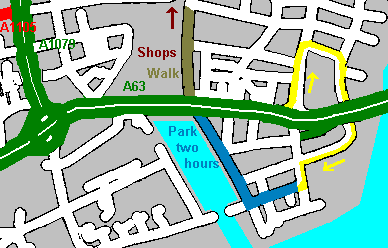
|
Spring Bank Restricted
Overhead railway bridge being altered and involved road closure late 2013 is now sorted out. A new bridge spans the road.
|
|
|
Lowgate has Been Restricted
It's had one way running for a while and has returned to its restricted condition
|
|
|
Ferensway closed
Click for map of closure of north bound Ferensway back in May and June 2006
|
North Bridge was closed
Click for map of closure of North Bridge March to September 2005
|
|
Buses dispersed
|
Railway Humber
|
| During the Covid pandemic in 2021 roads were restricted to add in cycle lanes experimentally. Had they been taken away again, the roads would have been repaired via government funding. But they are still there, despite the 'box' being for cars so that bicycles and buses can run into the city more directly. The result? Queues of cars due to restricted road space. |
| Queues in Hull are notorious, given the original loss of roadspace. Hull's transport situation had been a more significant mess for some time and reached its lowest point in 2005. North Bridge was closed from March, and stayed close until the middle of November, longer than expected. Then the roads were restored with normal queues at rush hours: in May 2006 chaos returned with the closure of Ferensway northbound. The journey south was restricted in part to 20 mph. This has now been restored to normal. But in 2020 onwards changes reduced roadspace even further. |
| I remember the days of the green wave one way system and few queues. Then came the Clive Sullivan Way, the double bend Daltry Street flyover, and a two lanes each way connector in Castle Street and Garrison Road (partly three lanes) to the A1033 and Hedon Road. Castle Street is inadequate, with a cut-through roundabout (called Mytongate) at its west end, and a series of pedestrian lights leading to traffic lights at its east end. |
| With that connector, a box system was set up with extended pedestrianisation in the centre. This has meant less road space for through cars, and few alternatives. This box is so restrictive that when part of it fails or is unavailable, it causes massive congestion. |
| The A1033 east of Hull in an east-west direction has been improved, but it adds to the Castle Street bottleneck. The bottleneck impacts on the large volume of traffic delivered from the Clive Sullivan Way and Hessle Road from the west. When Ferensway north was closed, all the traffic northbound has to go around three sides of the box. Alternative routes were considerably slowed. |
| The latest wheeze has been to close one of the access points on to the A63. It was a bad place for traffic, but that was because there were so few access points on to the A63 Castle Street. So what did they do? They stopped traffic going across the road. No alternative is signposted - the road cuts the area in two because it is too busy. Now this road is being improved, to have a flyover at a critical junction with the road for Beverley and a pedestrian bridge. |

| In 2007 work took place to end a traffic lights junction that not only allowed people out of the Old Town south of the A63 to go east towards Withernsea, and let people out of the Old Town north of the A63 to go west, but connected up the Old Town across this road. In rush hours the traffic queues stretched back through Lowgate as the road space filled up. So a solution was found - stop the traffic turning and going across. They filled in the central reservation. One impact of this was on me, because coming from the west I turned right to go to roads where parking was free and for two hours, to then walk to Princes Quay shopping or beyond. This is no longer possible. However, there is a road that goes under the A63 as it rises to go over the River Hull. You would think this route - and it is sensible to cross underneath - would be signposted. It is not signposted at all. |
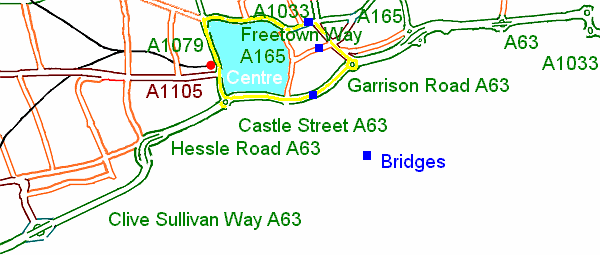
| In 2006 the closure of Ferensway northbound for redevelopment of the bus station and retailing put enormous pressure on the through routes. Bus lanes put in place with the earlier North Bridge closure, and the "bus gate" stopping city centre through traffic, continued to operate and restrict space as indeed they still do. |
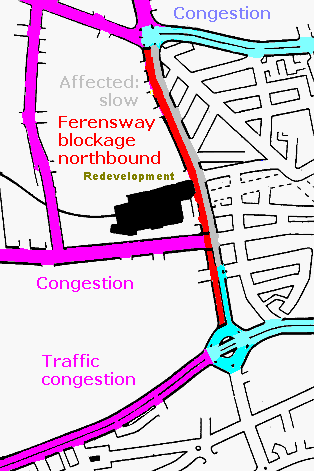
| Clearly if there is an accident on one of the box roads, or the Myton bridge swings open, the queues become enormously long. |
| The importance of buses has been emphasised and yet it was in 2004 that the bus station was closed and developed in 2007. Some buses can now leave at the 'back way' at Park Street. |
| In 2005 the situation first became very difficult for cars. From March 7th 2005 until November 15th North Bridge was completely closed for repairs. This bridge processes 42000 vehicles a day and when it closes to let a ship through traffic is intense. |
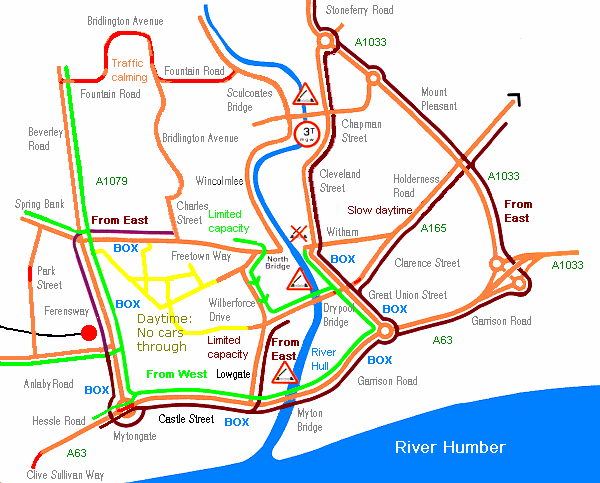
| It only takes one accident on a 'box' road to produce crippling queues, especially since the pandemic and reducing two lanes to one. |
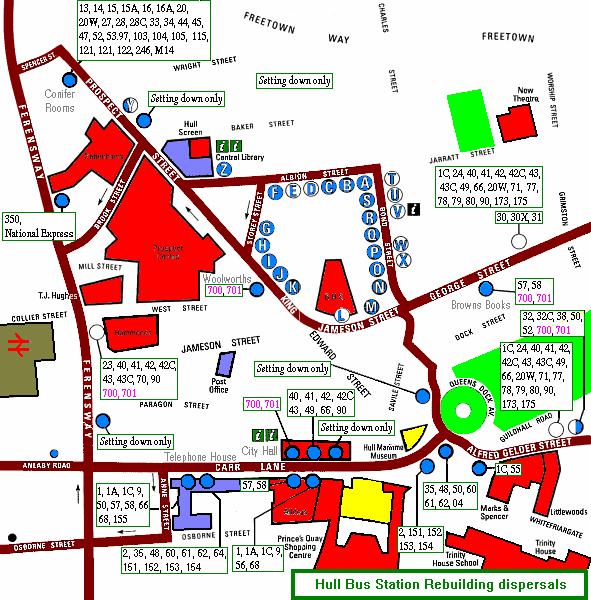
| The result has been the spreading of bus stands around city centre streets. A "bus gate" was introduced for the daytime at the western end of Victoria Square, thus cutting off the only possible through route within the city centre, forcing cars to keep to the 'box' for a through route. |
| Hull needs transport investment. Hessle railway station needs moving along to the Priory Park and Ride so that a fast link is made from the car park to the city. Car space needs increasing and the grade separated junction coming to Castle Street A63 is vital. Dedicated busways would be useful. Use should be made of the admittedly indirect high level railway for passenger use, with some tramline extensions from it to penetrate residential areas. Public transport is not yet swift enough from the car parks. |
| Coming from south of the Humber, its is best to park at Barton-on-Humber station free car park and get the bus, saving much of the car bridge fee. Connections between bus and train that should happen at Barton-on-Humber are often ignored by both bus and train. The railway is often late or not running, and the buses get stuck in Hull traffic as desperate car drivers block up bus lanes. The bus journey is still slow, however, when what is needed is an express. What is really missing is the 1930's idea for a railway bridge across the Humber. |

|
| People are already car sharing over the bridge (this is why people park all day on the A1077 just off the Humber Bridge roundabout) due to the cost, but this is not a congestion charge but a debt charge (in fact a congestion charge would not work in Hull: the box routes are through routes from other towns and villages; the traffic is effectively excluded by cul-de-sac in the city centre and now Lowgate is severely restricted). |
|
Hull City Council East Yorkshire Motor Services (Buses) Stagecoach (Buses) National Express (Coaches) Humberside Airport Network Rail Hull Trains Ferries |
Adrian Worsfold
Pluralist - Liberal and Thoughtful